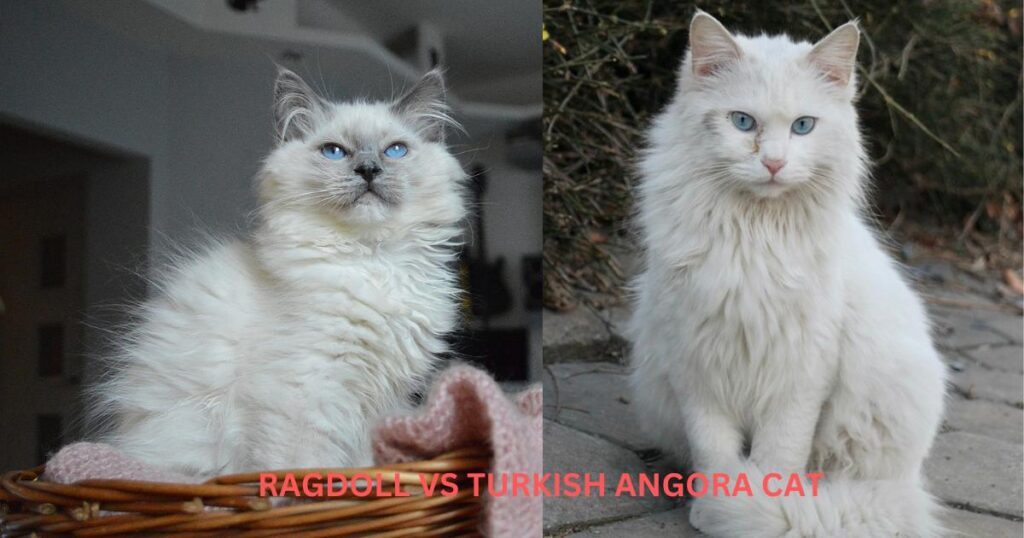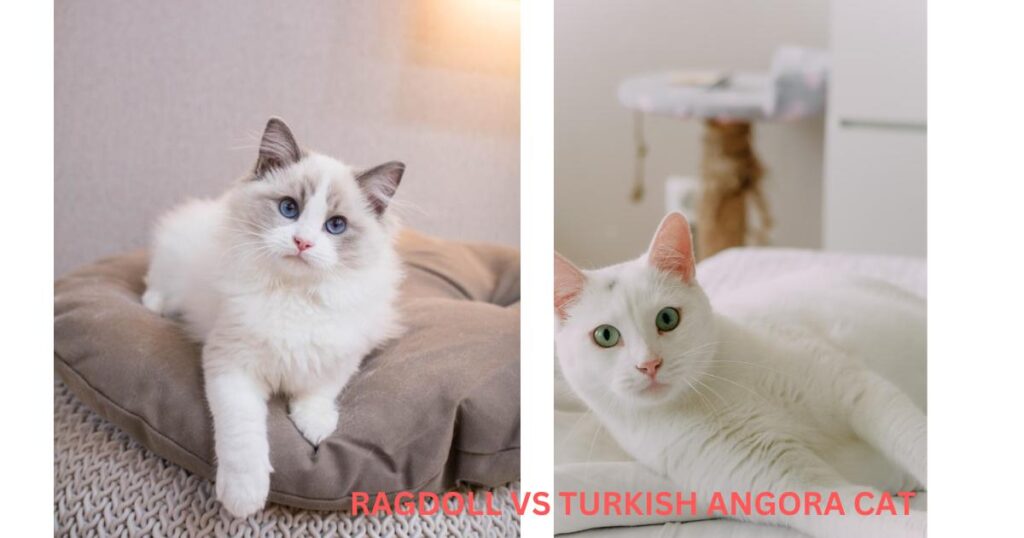Choosing the perfect cat is a big decision. After all, your feline companion will be part of your life for years, so it’s important to find the right match for your lifestyle and personality. If you’re torn between the Ragdoll and Turkish Angora, two popular breeds known for their striking looks and charming personalities, you’ve come to the right place. Both breeds have their own set of unique traits, but they cater to different types of cat lovers.
In this comparison, we’ll explore the key differences and similarities between the Ragdoll and Turkish Angora, helping you determine which cat breed is the perfect fit for you. Whether you’re looking for a snuggly lap cat or an energetic playmate, you’ll have all the information you need to make an informed decision.
Visual Differences
| Feature | Ragdoll | Turkish Angora |
|---|---|---|
| Size | Large, 15-20 lbs | Medium, 5-10 lbs |
| Coat | Thick, plush, needs regular grooming | Silky, fine, minimal grooming |
| Eyes | Always blue | Blue, green, amber, odd-eyed |
| Personality | Calm, affectionate, lap cat | Playful, intelligent, independent |
| Energy Level | Low to moderate | High energy, loves to explore |
| Sociability | Very social, great with other pets | Social but more assertive, may be territorial |
| Health | Prone to HCM | Prone to deafness in white cats |
| Lifespan | 12-15 years | 12-18 years |
Ragdoll vs Turkish Angora Cat: Overview
The Ragdoll breed was developed in the 1960s by a breeder named Ann Baker in California. The story goes that she started with a white long-haired cat named Josephine, who, after an accident, began producing kittens with a notably docile and relaxed temperament. These kittens were the foundation of the Ragdoll breed.
Ann selectively bred these cats to enhance their easygoing, gentle nature, leading to the calm, affectionate Ragdolls we know today. Over time, their popularity soared due to their stunning appearance and sweet personalities, making them one of the most beloved cat breeds in the world.
On the other hand, the Turkish Angora has a much older and more mysterious history. It’s believed that these cats originated in the mountains of Turkey and have been around for centuries. They are named after the capital city, Ankara (historically known as Angora), and are considered a national treasure in Turkey.
The breed was highly prized by royalty and was even mentioned in historical texts dating back to the 15th century. White Turkish Angoras were often kept in the palaces of sultans. In the 20th century, Turkey took steps to protect the breed from extinction, and now they are known worldwide for their elegance, intelligence, and independent personalities.

Physical Characteristics
Size and Build
The most obvious difference you’ll notice is their size. Ragdolls are big, sturdy cats that can weigh up to 20 pounds in males, while Turkish Angoras are much more slender and light, usually between 5-10 pounds.
Ragdolls have a heavy, plush feel, while Angoras are more delicate and graceful. If you’re looking for a larger cat with a more solid, cuddly presence, a Ragdoll fits the bill.
On the other hand, Turkish Angoras are built for agility and elegance, often looking like they could jump to the top of the highest shelf without much effort.
Eyes and Appearance
Ragdolls are famous for their striking blue eyes, which are a breed standard. It’s one of their signature traits, giving them an irresistibly sweet and dreamy look.
Turkish Angoras, on the other hand, have more variety in eye color. You’ll see blue, green, amber, and even the rare and captivating odd-eyed look (where each eye is a different color). If you’re drawn to unique eye colors, the Angora offers more diversity in this department.
Coat and Color
The Ragdoll cat has a semi-longhaired coat. It is smooth and silky, and it comes in different color points, such as seal, blue, chocolate, or lilac. They have a light coat on most of their body, but dark parts on their ears, face, paws, or tail.
Turkish Angoras have medium-long fur. It is shiny and fine. Most of them are white, but some come in other colors such as black, blue, and red. This is because their hairs are prone to tangles and mats. This makes them easier to care for.

Personality and Temperament
Personality is often the most important factor in choosing a cat, and Ragdolls and Turkish Angoras differ greatly in this regard.
Ragdolls are famous for their calm, docile demeanor. They’re incredibly affectionate, often compared to dogs for their loyalty and desire to follow their owners around.
Ragdolls are known for going limp when picked up (hence the name “Ragdoll”), and they’re perfect for someone who wants a cat that enjoys being held and cuddled.
They’re easygoing, great with kids, and typically get along well with other pets. Ragdolls are also relatively quiet, making them a great fit for peaceful households.
Turkish Angoras, by contrast, are more independent and playful. They are highly intelligent, and energetic, and love exploring their surroundings.
Turkish Angoras can be more vocal, and they enjoy being the center of attention but on their terms. They’re also excellent climbers and love heights, so don’t be surprised if you find your Turkish Angora perching on top of your bookshelves or darting around the house.
They enjoy interactive play and will keep you entertained with their lively, curious nature.

Sociability with Other Pets:
Ragdolls are generally easygoing and get along well with other pets, including dogs and other cats. Their gentle nature makes them adaptable to multi-pet households, and they’re likely to fit in smoothly with existing pets.
Turkish Angoras are also sociable but can be a bit more assertive and territorial. They may need a little more time to adjust to new pets, especially if they feel their territory is being encroached upon. With proper introductions, they can get along with other animals, but they might assert themselves more than a Ragdoll would.
Health and Lifespan
Ragdoll: Ragdolls are generally healthy but can be prone to heart conditions like hypertrophic cardiomyopathy (HCM). Regular vet check-ups and proper care can help manage any potential health concerns.
- Lifespan: 12-15 years
Turkish Angora: Turkish Angoras are also a healthy breed but may carry a genetic predisposition to deafness, especially in white cats with blue eyes. They are otherwise considered robust and have few hereditary health issues.
- Lifespan: 12-18 years

Grooming Requirements
Both breeds have long, luxurious coats, but their grooming needs differ significantly.
Ragdolls have thick, plush fur that requires regular grooming to prevent matting and tangles. While their fur is less prone to matting than some other long-haired breeds, a consistent brushing routine is essential, especially during shedding season.
They also benefit from regular nail trimming and ear cleaning, as their easygoing nature means they won’t put up much of a fight when it’s grooming time.
Turkish Angoras, despite their long fur, have silky coats that are much easier to maintain. They don’t mat as easily, so brushing once or twice a week is usually sufficient to keep their fur looking sleek and healthy.
Their lower-maintenance grooming needs make them a good choice for someone who wants a long-haired cat without the hassle of frequent brushing.
- Ragdoll: Requires regular grooming for their thick coat
- Turkish Angora: Minimal grooming despite having long fur
Ragdoll Vs Turkish Angora: Cost
Ragdolls and Turkish Angoras are both expensive breeds of cats to purchase, with kittens costing anywhere between $1000 – $4000 for a Ragdoll and $650 to $2000 for a Turkish Angora.
This price difference depends on factors such as lineage, location of the breeder, and color/pattern of coat.
Final Verdict: Ragdoll vs Turkish Angora – Which is Best for You?
Ultimately, the choice between a Turkish Angora vs Ragdoll comes down to your lifestyle and the type of relationship you want with your cat.
If you want a calm, cuddly companion who loves to be held, the Ragdoll is perfect for you. They are laid-back, affectionate, and great with children and other pets, but require regular grooming due to their thick fur. Ragdolls are ideal for quieter homes where they can relax and enjoy constant human companionship.
If you prefer an independent, playful, and energetic cat, the Turkish Angora is a better fit. They are active, curious, and love exploring their environment. Turkish Angoras require less grooming and are more vocal, making them great for active households or owners who want a lively, interactive cat.
In the end, both breeds offer wonderful companionship; it’s just a matter of whether you want a cozy lap cat or an active, engaging playmate!

Hey guys, My name is Simon Smith. I’m from Canada and live near Victoria
I live with my sweet family and have 20+ Ragdolls of different types. I love them as my children. My profession is as a hotel manager.
I love to keep Ragdolls and grow their breeder case. I have 7 years of experience.
I’m an expert in cat care. So, I’m here to provide you with new information about my cats daily. This is my blog website, so I request that you kindly visit our site daily.
If you’re a Ragdolls lover and you have any questions or confusion about cats, text me on the Contact Us page or Gmail.
Thank u
